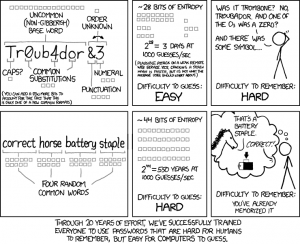I’m not actually that good with grammar. I certainly don’t consider myself a stickler or anywhere near the level of an expert when it comes to the finer points of the English language.
I often refer to Grammar Girl (or my handy Canadian Press Style Guide) to avoid common pitfalls of punctuation, capitalization and other grammatical fundamentals.
However, I do have several grammatical pet peeves that sometimes transform me into a rabid dog—and I’m not the only one.
If you want to avoid causing your readers to foam unpleasantly at the mouth, please take a moment to see if you’re guilty of these annoying grammar mistakes.
Rid Your Writing of These Annoying Grammar Mistakes
1: The Passive versus the Active Voice
I’ve been working hard to eliminate the passive voice from my writing. My goal is to write more clearly and avoid overly complicated sentences.
It hasn’t been an easy thing to do. First, I had to learn the difference between the passive and the active voice. Then, I had to learn how to write more actively.
If, like me, you’re wondering what the distinctionis between two, here’s the definition:
When using the active voice, the subject of the sentence performs the action expressed by the verb. In the passive sentence, the action is performed by the sentence subject.
Active:
Agatha slammed on her brakes as her car sped downhill.
Passive:
The brakes were slammed on by Agatha as her car sped downhill.
See the difference?
2: It’s or Its
People of earth, listen up.
This rule is tough for many people to remember. Most of the time, you use an apostrophe to indicate the possessive. However “it’s” is the exception to the rule. The only way to learn the proper usage is to memorize the difference between “it’s” and “its.”
“ It’s” means “it is” as in:
It’s a long way to California from Toronto.
“Its” is possessive as in:
Its mane is matted.
As for “its’”, this rule is an easy one—there’s no such word.
3: Fewer versus Less
The simple rule on how to use “fewer” versus “less” is to write the former when referring to things you can count (fewer than two cats) and “less” when you’re referring to things you can’t count (less than a gallon of paint, less paper).
According to Grammar Girl, you “can’t count candy, water, or potato salad—so you eat less candy, observe that the lake has less water, and make less potato salad for the next potluck.”
Of course, there are exceptions to the rule (aren’t there always?).
The Chicago Manual of Style advises to use “less than” before a plural noun that refers to distance, an amount, or a measure of time: less than 200 kilometres, less than $ 50, less than 10 weeks.
4: Lie or Lay
The present tense rule on how to use “lie” versus “lay” is easy. “Lie” is the verb that means “to recline” and “lay” always requires an object, as in “lay the book on the table.”
Things get tricky and downright impossible in the past tense, since “lay” is the past tense of “lie.” Unless you’re a true grammar nerd, I recommend looking up the proper usage when using these verbs.
Correct usage:
Every afternoon the couple lie down for a short nap
Steph lay [past tense of “lie”] on the beach (May 14, 2015) and enjoyed the sunshine
I recall laying my keys by the phone
For a thorough discussion of “lay” versus “lie,” read this post from Get It Write Online.
5: They’re, Their or There
If you missed the class on homonyms in grade one, the difference between “they’re,” “their” and “there” may confuse you.Homonyms are words that sound the same when spoken, but have very different meanings.
“They’re” is a contraction, with the apostrophe standing in for the missing letter “a.” It means “they are” as in “they’re in the playground on the basketball court.”
“Their” is the possessive form of “they” as in “the girls left their jackets in a heap by the door.”
Finally, we use “there” to name a place: “I’ve never been there before.”
6: Your versus You’re
There are all kinds of homonyms in the English language (bale vs. bail; flew vs. flu vs. flue; knight vs. night). “Your” and “you’re” are 2 more common ones some people confuse.
The apostrophe in “you’re” replaces the missing “a” and means “you are”:
I think it’s better when you’re not involved.
“Your” is the possessive form for you:
Your dog barked all night long.
Got it?
7: Me or I
There’s an easy test to make sure you’re using these words correctly. Just remove the other person from the sentence and, if it makes sense, you’re good.
Here’s an example:
Pass the guacamole to Nancy and I when you’re done.
This sentence is incorrect. Remove “Nancy” and you have:
Pass the guacamole to I when you’re done.
It sounds wrong—and it is. You would never ask someone to pass something to “I.”
Rewrite the sentence using “me” and it’s perfect:
Pass the guacamole to Nancy and me when you’re done.
Bonus tip: “Myself” is only used when you’ve already referred to yourself in a sentence. It’s called a reflexive pronoun (you don’t need to know what it’s called, just how to use it properly). The general rule is you cannot use the pronoun “myself” in a sentence unless the pronoun “I” is used before it.
Here’s how:
I kept half the cookies for myself.
I will go to the library myself to check on the magazines.
I see myself in my daughter.
8: Affect versus Effect
“Affect” is a verb (the speaker affected me greatly); while “effect” is a noun (the speaker had a great effect on me).
I use a simple trick to remember the difference between these 2. Since “affect” is a verb, I use the initials AV (where the “a” stands for “affect” and “v” stands for verb), the abbreviation for audio-visual, to remember which one to use.
9: Dos and Don’ts
If you follow the dos and don’ts of the Canadian Press Stylebook (or the Chicago Manual of Style), these 2 words will be a piece of cake for you. Just add an “s” to both “do” and “don’t” to make them plural.
Simple!
Of course, nothing is straightforward when it comes to English grammar. The Associated Press recommends “do’s” and “don’ts,” while others suggest “do’s” and “don’t’s”.
In other words, you can write whatever you want … but I’m sticking to my Canadian roots on this one.
10: Who versus That
The rather simple, but effective, rule of thumb is to use “who” when referring to people and “that” when referring to objects:
Deirdre is the one who picked up the paper.
Samuel belongs to the group that focuses on environmental concerns.
Of course, if you want to over-complicate things, you can. Feel free HERE.
Be Brief (But Don’t Cut Corners)
Whether you’re writing a blog post, an eBook or a budget recommendation to your boss, your reader will appreciate a well-crafted document that avoids common—and annoying—mistakes.
Even a casual email to a colleague or a friend is easier to understand when it follows simple English grammar rules. (The only time I might let you off the hook is when you’re writing a grocery shopping list, which typically involves very little grammar.)
Don’t make your readers work to understand your meaning. It’s okay to be brief, but don’t cut corners, when it comes to proper word use, punctuation and writing style.
Is there a grammar mistake that turns you into a rabid dog? Add your pet peeves to the comments.
(233)





